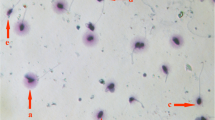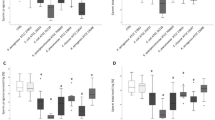Abstract
Purpose
To evaluate whether ejaculated human spermatozoa undergo complete apoptosis or necrosis during experimental semen bacterial infection in vitro.
Methods
Apoptotic markers, including mitochondrial transmembrane potential (ΔΨm), phosphatidylserine (PS) externalization, and DNA fragmentation, have been detected simultaneously in ejaculated human sperm after their incubation with a known pathogenic (Escherichia coli), as well as with conditionally pathogenic bacterial strains (Staphylococcus haemolyticus, Bacteroides ureolyticus) and/or leukocytes. The ΔΨm and translocation of PS was evaluated using the JC-1 and Annexin V binding tests, respectively. A modified TUNEL assay with additional staining for sperm viability was used to detect the DNA fragmentation level.
Results
The exposure of ejaculated spermatozoa to bacterial strains was associated with a simultaneous decrease in the percentage of sperm with normal ΔΨm and an increase in the proportion of Annexin V-positive sperm. Additionally, in the presence of S. haemolyticus, B. ureolyticus and/or leukocytes, a significant increase in the percentage of live TUNEL-positive (apoptotic) as well as dead TUNEL-positive (necrotic) sperm cells was also observed.
Conclusions
The cellular death observed in spermatozoa in the presence of inflammatory mediators may be due to both apoptosis and necrosis. Here, we demonstrate for the first time that direct contact of conditionally pathogenic bacteria with ejaculated human sperm may play an even greater role in the promotion of apoptosis than in case of some pathogenic bacterial strains. These findings suggest that significant bacteriospermia and leukocytospermia may be direct causes of subfertility or additional negative factors worsening the prognosis of fertility in natural and assisted procreation.



Similar content being viewed by others
References
Cottell E, Harrison RF, McCaffrey M, Walsh T, Mallon E, Barry-Kinsella C. Are seminal fluid microorganisms of significance or merely contaminants? Fertil Steril. 2000;74:465–70.
Moretti E, Capitani S, Figura N, Pammolli A, Federico MG, Giannerini V, et al. The presence of bacteria species in semen and sperm quality. J Assist Reprod Genet. 2009;26:47–56.
Barraud-Lange V, Pont JC, Pocate K, Kunstmann JM, Chalas-Boissonas C, Ducot B, et al. Seminal leukocytes and clinical outcomes with donor sperm insemination. Fertil Steril. 2011;96:1320–4. e1.
Cavagna M, Oliveira JB, Petersen CG, Mauri AL, Silva LF, Massaro FC, et al. The influence of leukocytospermia on the outcomes of assisted reproductive technology. Reprod Biol Endocrinol. 2012;10:44. doi:10.1186/1477-7827-10-44.
Villegas J, Schulz M, Soto L, Sanchez R. Bacteria induce expression of apoptosis in human spermatozoa. Apoptosis. 2005;10:105–10.
Allam JP, Fronhoffs F, Fathy A, Novak N, Oltermann I, Bieber T, et al. High percentage of apoptotic spermatozoa in ejaculates from men with chronic genital tract inflammation. Andrologia. 2008;40:329–34.
Domes T, Lo KC, Grober ED, Mullen JB, Mazzulli T, Jarvi K. The incidence and effect of bacteriospermia and elevated seminal leukocytes on semen parameters. Fertil Steril. 2012;97:1050–5.
La Vignera S, Condorelli R, D’Agata R, Vicari E, Calogero AE. Semen alterations and flow-citometry evaluation in patients with male accessory gland infections. J Endocrinol Investig. 2012;35:219–23.
Grassmé H, Jendrossek V, Gulbins E. Molecular mechanisms of bacteria induced apoptosis. Apoptosis. 2001;6:441–5.
Diemer T, Weidner W, Michelmann HW, Schiefer HG, Rovan E, Mayer F. Influence of Escherichia coli on motility parameters of human spermatozoa in vitro. Int J Androl. 1996;19:271–7.
Köhn FM, Erdmann I, Oeda T, el Mulla KF, Schiefer HG, Schill WB. Influence of urogenital infections on sperm functions. Andrologia. 1998;30:73–80.
Eley A, Hosseinzadeh S, Hakimi H, Geary I, Pacey AA. Apoptosis of ejaculated human sperm is induced by co-incubation with Chlamydia trachomatis lipopolysaccharide. Hum Reprod. 2005;20:2601–7.
Satta A, Stivala A, Garozzo A, Morello A, Perdichizzi A, Vicari E, et al. Experimental Chlamydia trachomatis infection causes apoptosis in human sperm. Hum Reprod. 2006;21:134–7.
Berktas M, Aydin S, Yilmaz Y, Cecen K, Bozkurt H. Sperm motility changes after coincubation with various uropathogenic microorganisms: an in vitro experimental study. Int Urol Nephrol. 2008;40:383–9.
Schulz M, Sánchez R, Soto L, Risopatrón J, Villegas J. Effect of Escherichia coli and its soluble factors on mitochondrial membrane potential, phosphatidylserine translocation, viability, and motility of human spermatozoa. Fertil Steril. 2010;94:619–23.
Fraczek M, Piasecka M, Gaczarzewicz D, Szumala-Kakol A, Kazienko A, Lenart S, et al. Membrane stability and mitochondrial activity of human-ejaculated spermatozoa during in vitro experimental infection with Escherichia coli, Staphylococcus haemolyticus and Bacteroides ureolyticus. Andrologia. 2012;44:315–29.
Fraczek M, Wiland E, Piasecka M, Boksa M, Gaczarzewicz D, Szumala-Kakol A, et al. Fertilizing potential of ejaculated human spermatozoa during in vitro semen bacterial infection. Fertil Steril. 2014;102:711–9. e1.
World Health Organization. WHO laboratory manual for the examination and processing of human semen. 5th ed. Geneva: WHO Press; 2010.
Endtz AW. A rapid staining method for differentiating granulocytes from germinal cells in Papanicolau-stained semen. Acta Cytol. 1974;18:2–7.
Fraczek M, Szumala-Kakol A, Jedrzejczak P, Kamieniczna M, Kurpisz M. Bacteria trigger oxygen radical release and sperm lipid peroxidation in in vitro model of semen inflammation. Fertil Steril. 2007;88:1076–85.
Beutin L, Miko A, Krause G, Pries K, Haby S, Steege K, et al. Identification of human-pathogenic strains of Shiga toxin-producing Escherichia coli from food by a combination of serotyping and molecular typing of Shiga toxin genes. Appl Environ Microbiol. 2007;73:4769–75.
Piasecka M, Kawiak J. Sperm mitochondria of patients with normal sperm motility and with asthenozoospermia: morphological and functional study. Folia Histochem Cytobiol. 2003;41:125–39.
Mitchell LA, De Iuliis GN, Aitken RJ. The TUNEL assay consistently underestimates DNA damage in human spermatozoa and is influenced by DNA compaction and cell vitality: development of an improved methodology. Int J Androl. 2011;34:2–13.
Fraczek M, Szumala-Kakol A, Dworacki G, Sanocka D, Kurpisz M. In vitro reconstruction of inflammatory reaction in human semen: effect on sperm DNA fragmentation. J Reprod Immunol. 2013;100:76–85.
Muratori M, Porazzi I, Luconi M, Marchiani S, Forti G, Baldi E. AnnexinV binding and merocyanine staining fail to detect human sperm capacitation. J Androl. 2004;25:797–810.
Martin G, Sabido O, Durand P, Levy R. Phosphatidylserine externalization in human sperm induced by calcium ionophore A23187: relationship with apoptosis, membrane scrambling and the acrosome reaction. Hum Reprod. 2005;20:3459–68.
Marchetti P, Ballot C, Jouy N, Thomas P, Marchetti C. Influence of mitochondrial membrane potential of spermatozoa on in vitro fertilisation outcome. Andrologia. 2012;44:136–41.
Marchetti C, Jouy N, Leroy-Martin B, Defossez A, Formstecher P, Marchetti P. Comparison of four fluorochromes for the detection of the inner mitochondrial membrane potential in human spermatozoa and their correlation with sperm motility. Hum Reprod. 2004;19:2267–76.
Marchetti C, Obert G, Deffosez A, Formstecher P, Marchetti P. Study of mitochondrial membrane potential, reactive oxygen species, DNA fragmentation and cell viability by flow cytometry in human sperm. Hum Reprod. 2002;17:1257–65.
Wang X, Sharma RK, Gupta A, George V, Thomas AJ, Falcone T, et al. Alterations in mitochondria membrane potential and oxidative stress in infertile men: a prospective observational study. Fertil Steril. 2003;80:844–50.
Barroso G, Taylor S, Morshedi M, Manzur F, Gaviño F, Oehninger S. Mitochondrial membrane potential integrity and plasma membrane translocation of phosphatidylserine as early apoptotic markers: a comparison of two different sperm subpopulations. Fertil Steril. 2006;85:149–54.
Koppers AJ, De Iuliis GN, Finnie JM, McLaughlin EA, Aitken RJ. Significance of mitochondrial reactive oxygen species in the generation of oxidative stress in spermatozoa. J Clin Endocrinol Metab. 2008;93:3199–207.
Espinoza JA, Schulz MA, Sánchez R, Villegas JV. Integrity of mitochondrial membrane potential reflects human sperm quality. Andrologia. 2009;41:51–4.
Aitken RJ, Baker MA. Causes and consequences of apoptosis in spermatozoa; contributions to infertility and impacts on development. Int J Dev Biol. 2013;57:265–72.
Burrello N, Salmeri M, Perdichizzi A, Bellanca S, Pettinato G, D’Agata R, et al. Candida albicans experimental infection: effects on human sperm motility, mitochondrial membrane potential and apoptosis. Reprod Biomed Online. 2009;18:496–501.
Collodel G, Baccetti B, Capitani S, Moretti E. Necrosis in human spermatozoa. I. Ultrastructural features and FISH study in semen from patients with uro-genital infections. J Submicrosc Cytol Pathol. 2005;37:67–73.
Lu Y, Bhushan S, Tchatalbachev S, Marconi M, Bergmann M, Weidner W, et al. Necrosis is the dominant cell death pathway in uropathogenic Escherichia coli elicited epididymo-orchitis and is responsible for damage of rat testis. PLoS One. 2013;8:e52919.
Boguen R, Uribe P, Treulen F, Villegas JV. Distinct isolates of uropathogenic Escherichia coli differentially affect human sperm parameters in vitro. Andrologia. 2013;46:943–7.
Rodin DM, Larone D, Goldstein M. Relationship between semen cultures, leukospermia, and semen analysis in men undergoing fertility evaluation. Fertil Steril. 2003;79:1555–8.
Stovall DW, Bailey LE, Talbert LM. The role of aerobic and anaerobic semen cultures in asymptomatic couples undergoing in vitro fertilization: effects on fertilization and pregnancy rates. Fertil Steril. 1993;59:197–201.
Eggert-Kruse W, Probst S, Rohr G, Aufenanger J, Runnebaum B. Screening for subclinical inflammation in ejaculates. Fertil Steril. 1995;64:1012–22.
Krzymińska S, Szczuka E, Kaznowski A. Staphylococcus haemolyticus strains target mitochondria and induce caspase-dependent apoptosis of macrophages. Antonie Van Leeuwenhoek. 2012;102:611–20.
Balmelli T, Stamm J, Dolina-Giudici M, Peduzzi R, Piffaretti-Yanez A, Balerna M. Bacteroides ureolyticus in men consulting for infertility. Andrologia. 1994;26:35–8.
Aitken RJ, Koppers AJ. Apoptosis and DNA damage in human spermatozoa. Asian J Androl. 2011;13:36–42.
Villegas J, Schulz M, Soto L, Iglesias T, Miska W, Sánchez R. Influence of reactive oxygen species produced by activated leukocytes at the level of apoptosis in mature human spermatozoa. Fertil Steril. 2005;83:808–10.
Zorn B, Ihan A, Kopitar AN, Kolbezen M, Sesek-Briski A, Meden-Vrtovec H. Changes in sperm apoptotic markers as related to seminal leukocytes and elastase. Reprod Biomed Online. 2010;21:84–92.
Mupfiga C, Fisher D, Kruger T, Henkel R. The relationship between seminal leukocytes, oxidative status in the ejaculate, and apoptotic markers in human spermatozoa. Syst Biol Reprod Med. 2013;59:304–11.
Said T, Agarwal A, Grunewald S, Rasch M, Baumann T, Kriegel C, et al. Selection of nonapoptotic spermatozoa as a new tool for enhancing assisted reproduction outcomes: an in vitro model. Biol Reprod. 2006;74:530–7.
Muratori, M, Tamburrino L, Marchiani S, Azzari C, Forti G, Baldi E. Investigation of the origin of sperm DNA fragmentation: the role of apoptosis, immaturity and oxidative stress. Proceedings of the 8th Congress of the European Academy of Andrology; 2014 October 15–17; Barcelona, Spain. American Society of Andrology and European Academy of Andrology.
Fourie J, Loskutoff N, Huyser C. Elimination of bacteria from human semen during sperm preparation using density gradient centrifugation with a novel tube insert. Andrologia. 2012;44:513–7.
Acknowledgments
The authors wish to thank Anna Czernikiewicz, M.Sc. for blood sample processing. Tomasz Kolanowski is a scholarship recipient of EU 8.2.2 OP- Innovative Economy.
Grant support
This work was financed by Ministry of Science and Higher Education grant No. NN 407283539 and National Centre for Research and Development grant No. NR 13006606.
Ethical statement
This study was approved by the Local Bioethical Committee of Medical University of Poznan, Poland. Informed consent was obtained from all the participants included to the study.
Conflict of interest
The authors declare that they have no conflict of interest.
Author information
Authors and Affiliations
Corresponding author
Additional information
Capsule Ejaculated human spermatozoa undergo complete apoptosis and necrosis during semen bacterial infection; it is possible to induce sperm apoptosis/necrosis in the presence of conditionally pathogenic bacterial strains.
Electronic supplementary material
Below is the link to the electronic supplementary material.
Supplementary Table 1
(DOCX 16 kb)
Rights and permissions
About this article
Cite this article
Fraczek, M., Hryhorowicz, M., Gaczarzewicz, D. et al. Can apoptosis and necrosis coexist in ejaculated human spermatozoa during in vitro semen bacterial infection?. J Assist Reprod Genet 32, 771–779 (2015). https://doi.org/10.1007/s10815-015-0462-x
Received:
Accepted:
Published:
Issue Date:
DOI: https://doi.org/10.1007/s10815-015-0462-x




